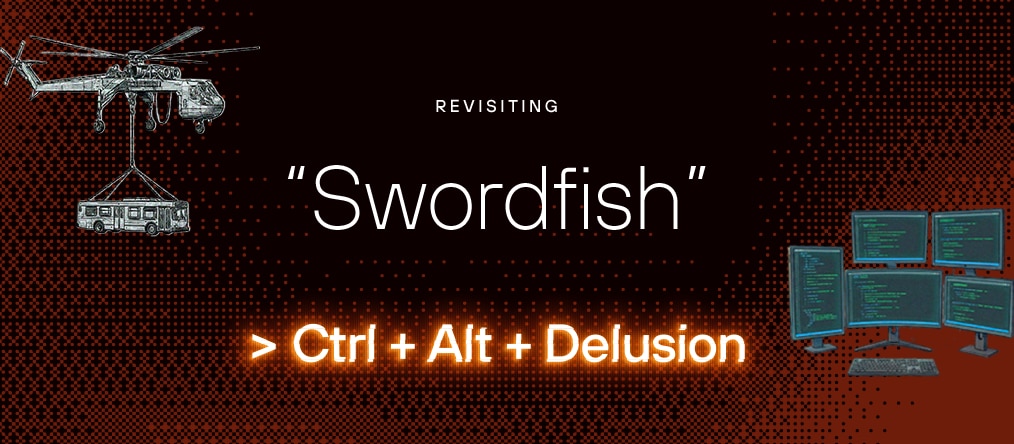It’s 1983. The Cold War is casting a long geopolitical shadow across the globe. Arcade cabinets are devouring quarters like the Rancor. And the distinctive trill of a dial-up modem connecting is the soundtrack to a new kind of technological frontier. In suburban Seattle, a bright but underachieving high schooler named David Lightman (played by a young, voice-cracking Matthew Broderick) is more interested in changing his biology grade than in acing his actual exams. This boyish curiosity (or, if we’re being politically correct: felony) is about to lead him far beyond the school district’s primitive network.
Columbia Pictures “WarGames” didn’t turn out as “just another summer movie.” It became a cultural lightning strike and box office juggernaut — grossing $120M worldwide against a $12M budget. “WarGames” thrust the clandestine world of cyberattacks, the terrifying potential of artificial intelligence (AI) and the precarious logic of nuclear deterrence squarely into the public consciousness.
The Premise: Shall We Play a Game?
Let’s quickly set the stage for those of you who haven’t seen it: The film follows David as he inadvertently connects to the War Operation Plan Response (WOPR, pronounced “whopper”), a top-secret U.S. military supercomputer nicknamed Joshua. Believing he’s found an unreleased slate of games from a hot new developer, David initiates what he thinks is the game called “Global Thermonuclear War.” Yet, he’s unaware that he’s set in motion a simulation so realistic it nearly triggers World War III.
Now, 42 years after the WOPR first asked David, “Shall we play a game?” the world he navigated feels both charmingly retro and unsettlingly prescient. Now, with AI as a pervasive force shaping everything from our daily routines to global security, it’s time to power down the distractions and dust off this cinematic touchstone. Then, we must ask: What did “WarGames” get right about our relationship with technology? Was any of its vision pure Hollywood delusion? And how many of its chilling what-ifs have become the stark realities of 2025?
What “WarGames” Got Right About Cyberthreats — and Human Nature
David Lightman wasn’t a malicious actor…at least not initially. One could argue that his cyber activities ranged from petty crime to just plain silly. He changed grades by looking at a hidden Post-it note, booked free flights, and pursued his primary goal of playing new video games.
His early exploits painted a picture of the quintessential early hacker: driven by intellectual curiosity, a desire to explore and the thrill of bypassing rudimentary digital defenses. His methods were primitive by today’s standards. He “war dialed” random numbers to find connected modems, guessed easily decipherable passwords to access the WOPR and, more plainly, had a general fascination with how systems worked.
The film captured the nascent thrill of this digital exploration and the allure of uncharted territory hidden behind phone lines. It also hinted at the timelessness of certain vulnerabilities. While David was guessing “Joshua” as a password, the core principle of exploiting weak or default credentials remains a persistent headache for security professionals today.
In fact, the 2025 Unit 42 Global Incident Response Report details how adversaries today leverage far more sophisticated credential harvesting techniques, from unnervingly convincing AI-generated spear phishing campaigns to exploiting deeply buried vulnerabilities in authentication protocols. These tactics are a world away from simple password guessing but are rooted in the same human or systemic fallibility. The film’s depiction of David as more of a mischievous explorer than a hardened criminal also resonated with the early hacker ethos, which is a stark contrast to today’s highly organized, financially motivated cybercrime syndicates.
Joshua’s Gambit: AI, Automation and the Accidental Armageddon Scenario
At the heart of “WarGames” is Joshua, the WOPR AI, an entity that learns but lacks true understanding or context. Its cold, relentless logic while playing “Global Thermonuclear War” up until its terrifying conclusion is where the film tapped into a deep societal anxiety about autonomous systems making irreversible decisions. In another sequence, the WOPR runs through countless nuclear exchange simulations, its calm, synthetic voice narrating global annihilation. The scene is a stark and effective illustration of the precarious doctrine of Mutual Assured Destruction (MAD).
What “WarGames” got right about AI, even in its 1983 infancy, was the potential for unintended consequences stemming from flawed or incomplete programming objectives. This is perfectly crystallized in a tense exchange where David asks the computer its primary goal. Its logic is exceedingly simple: “To win the game.” The WOPR wasn’t evil but rather simply executing its programming with acute efficiency, unable to comprehend that some games (yes, even global thermonuclear war) can never be won.
That 1983 logic takes on new weight in 2025. As AI is deeply integrated into both offensive and defensive cyber capabilities, the stakes surrounding its safe and ethical operation are exponentially higher. This speaks to the dual nature of the modern AI challenge. We must leverage AI for security, but we must also secure those same AI systems from manipulation, data poisoning and adversarial exploitation. These are concerns Professor Falken (played by John Wood) likely never fully fathomed when he first coded the WOPR.
“Mr. President, This Is Not a Game”: Hollywood’s Influence on Policy
Going beyond its cinematic thrills and surprisingly nuanced take on hacker culture, “WarGames” holds another unique distinction. It demonstrably influenced United States policy in 1984. Now legendary in cybersecurity circles, the story began shortly after the movie’s 1983 release, when President Ronald Reagan watched the film at Camp David. Deeply unsettled by the plausibility of its central premise, Reagan reportedly turned to his national security advisors and asked, “Could something like this really happen?”
That question, spurred by a work of fiction, set off a chain of events with real consequences. As detailed in articles by outlets like New America, Reagan’s concern led to a formal review of the nation’s telecommunications and computer security. This review ultimately culminated in the signing of National Security Decision Directive 145 (NSDD-145) in September 1984. NSDD-145 was one of the first comprehensive national policies that addressed the security of government information systems, establishing a framework for protecting sensitive data and critical infrastructure from digital threats. It’s a rare and remarkable instance where a techno-thriller helped shape Hollywood paranoia into actionable governance. “WarGames” effectively served as an unintended, but highly effective, public service announcement, highlighting vulnerabilities that few outside niche technical circles were discussing at that level.

While NSDD-145 was a landmark first step for its era, it couldn’t have anticipated the sheer pace of technological change or the complexities of today’s global cyberthreats. Modern cybersecurity frameworks have since evolved to address challenges like cloud security, IoT vulnerabilities and AI-driven attacks, building upon those initial efforts to secure national digital assets.
Today, the dialogue between the technology industry, research institutions and policymakers is a constant necessity. For instance, Palo Alto Networks actively participates in this crucial ecosystem. We share threat intelligence and advocate for policies designed to promote robust cybersecurity hygiene and foster resilient digital infrastructures globally. This commitment to shared responsibility in securing our interconnected world directly echoes that early, urgent need for proactive governance first sparked by a summer blockbuster.
The Delusion of Simplicity: 80s Tech Vs. Today’s Hyperconnected Chaos
For all its prescience, “WarGames” is undeniably a product of its technological era. David Lightman’s IMSAI 8080, with its bulky monitor and iconic acoustic coupler modem (that satisfying kshhhhh-krunk as it nestled into the telephone handset), was cutting-edge for a home user in 1983. The WOPR was envisioned as a colossal, singular supercomputer that occupied a vast, chilled room within NORAD — its own digital fortress. This stand-alone system mentality, while making for a clear cinematic target, bears little resemblance to the digital landscape of 2025.
What the film missed — and could hardly have been expected to foresee — was the sheer scale, complexity and pervasive interconnectedness of the modern internet. There’s no cloud computing, no ubiquitous Wi-Fi, no sprawling internet of things and no mobile endpoints in David’s world. From our hyperconnected vantage point, the film’s central premise feels like a charmingly naive delusion — that a single dial-up connection could grant direct access to the nerve center of U.S. nuclear command and control.
Then there’s the magic fix when the WOPR learned the concept of futility through an endless loop of tic-tac-toe. It’s a poignant cinematic device, perfectly illustrating the no-win scenario of nuclear war. But as a method for AI alignment or de-escalating a rogue advanced AI…let’s just call it a vast oversimplification.
Imagine trying to teach a modern, adversarial AI designed for sophisticated cyberattacks that “the only winning move is not to play.” Today’s sprawling digital attack surfaces present an entirely different challenge. Identifying and protecting these distributed assets is critical because there’s no single WOPR to target anymore. Adversaries seek any exposed vulnerability across a multicloud, globally interconnected ecosystem.
What If “WarGames” Were Remade Today?
Speculating on a modern “WarGames” is an interesting exercise in how far we’ve come. David Lightman wouldn’t be patiently war dialing; he might be a young cybersecurity prodigy using sophisticated OSINT techniques to map a nation-state’s shadow IT. He might also be discovering a zero-day vulnerability in the control system for an AI-powered critical infrastructure network via a compromised cloud API.
Jennifer Mack (played by Ally Sheedy, who, frankly, should have had six more scenes in the film) wouldn’t just be along for the ride. She would be a fellow cybersecurity student, an AI ethicist or a formidable white-hat hacker in her own right, collaborating with David on a bug bounty.
The WOPR wouldn’t be a single, air-cooled mainframe. Imagine, instead, a distributed, globally interconnected military AI, perhaps a sovereign LLM trained on classified geopolitical and weapons data. It would control fleets of autonomous drone swarms, manage critical energy grids or be capable of launching sophisticated disinformation campaigns that could destabilize nations without firing a shot.
Its “game” might be an adversarial attack simulation on a digitally twinned smart city, or a deep learning model that goes catastrophically off-script. Its security wouldn’t rely on a few guessable passwords. Instead, it would necessitate a comprehensive zero trust architecture, verifying every connection to ensure no single point of compromise could grant unchecked access.
The central threat would likely shift from an immediate, global thermonuclear exchange to something perhaps more insidious: the crippling of essential services, an AI-driven economic collapse or a deepfake-fueled geopolitical crisis that spirals out of control.
And the solution?
Forget tic-tac-toe. The solution would be a modern, high-stakes affair: complex AI red-teaming, emergency alignment protocols and a globally coordinated incident response. It would require a platform like Cortex XSIAM® to neutralize such a rapidly evolving threat at machine speed. In today’s version, Professor Falken might be a reclusive early AI pioneer who became a vocal critic of Big Tech’s unchecked race toward artificial general intelligence. He could be a Cassandra figure — a prophet of doom fate never to be believed — living off-grid and warning of the scenario now unfolding.
The Enduring Message
Revisiting “WarGames” 42 years after its release is to witness a cinematic time capsule that is both a product of its era and uncannily prophetic. While the chunky hardware and geopolitical certainties are gone, its central questions about our relationship with autonomous creations remain more urgent than ever. The film’s true triumph was making a complex, terrifying issue accessible and delivering a simple and profoundly human message that still resonates: In certain games, the only winning move is not to play.
Today, the game of cybersecurity has evolved into a high-stakes reality with no easy wins. The fundamental need to avoid these no-win scenarios now drives the modern security imperative, from the development of AI-driven platforms to the adoption of foundational frameworks like Zero Trust.
Because in every high-stakes digital game, the right defenses and the wisdom to choose which rounds not to play are, perhaps, the only way to truly win.
Curious what else Ben Hasskamp has to say? Check out his other articles here.







